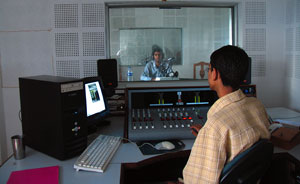 |
Community radio in Nepal is frequently celebrated as a model for radio broadcasting in South Asia. There are almost 200 licensed community stations on air across the country, often broadcasting to impoverished and remote areas. In theory, community radio props up grassroots democracy but there is a growing gap between the promise and reality of community radio in Nepal.
The phenomenal growth of community radio in Nepal has been without oversight. Ownership is increasingly dominated by local elite who start stations in the name of the community. Privileged class and castes and politically
well-connected males hold licenses through cooperatives or NGOs, whose limited objectives are often politically motivated, may be out of touch with the communities they serve.
Publicity is the lifeblood of politicians, and the widespread ownership of radio sets has naturally made community radio a targeted publicity tool for politicians. The Community Radio Support Center estimates that political parties directly or indirectly operate up to 60 per cent of community radios currently on air. A look at a map of community radios shows clusters of three or more stations in many areas across the country, an indication of counterbalancing efforts among the three main parties. Beyond the problem of the manipulation of news and views that may come with the politicisation of community media, competition means a push towards larger transmitters. Increased overhead costs lead to heavier reliance on commercial sources of revenue and a reorientation of community stations towards the market.
In a market-based model of media sustainability, the sponsors and advertisers are the buyers while the readers, listeners, and viewers are the consumers. Buyer demands usually overrule consumer demands, at least as long as they don't hamper the credibility of a media outlet to the extent that it turns off the media consumer. But the sustainability of community radio lies not in commercial sources but in the creation of social capital. When community stations rely on the market, they risk alienating the community. Other than profit or non-profit status, there is nothing to distinguish a community station from a commercial station in Nepal.
Even though many stations broadcast in several languages, the actual amount of time devoted to local language programming is small. Many programs in Nepali may not be fully relatable to local language speakers. Where stations increasingly rely on commercial sources of revenue, this situation is unlikely to change. Local language programming may have little attractiveness to advertisers due to a lack of purchasing power among local language listeners, exposing the market's limitations.
Syndicated programming centrally produced by NGOs and private production houses comprises a large percentage of community radio airtime. While this is a way for stations to cut costs and broadcast quality programming, it does reinforce traditional Kathmandu-centrism, eroding local orientation.
Stations outside of Kathmandu have been shown to have more news programs than stations established inside the Valley, primarily sourced from content providers based in Kathmandu and dominated by national politics. As such, community stations can be said to be as national in outlook as any commercial station.
Investigative pieces probing local corruption are seldom carried out, perhaps a result of safety concerns or pandering to political or financial patrons. While centrally produced programs on crucial issues such as constitution-making and federalism do incorporate local voices and offer quality analysis on complex subject matter to resource-strapped stations, it is clear that some of the most important decisions facing Nepalis are largely out of the reach of real grassroots participation.
A true community station requires local orientation and community accountability. Ownership by traditionally dominant local groups and political parties goes contrary to this ethic. There are numerous community radios which do exhibit excellent practices, but in many cases the word "community" has been captured for self-serving ends.
The Community Radio Performance Assessment System, a point-based method of scoring the "health" of community stations, is now identifying model community stations while providing incentives and support for stations with lower scores. Almost half of the total score is devoted to the local orientation of programming and community ownership and participation. The results should offer a good baseline from which an appropriate system of classification, development guidelines, and regulation can evolve in a sector emerging from its infancy. It is in the effort to reclaim the title of "community" that democratic processes in community radio can flourish and community radio can endure as a principal agent of democratisation.
Anthony Wille is with the Graduate Program in International Affairs, The New School, New York.


